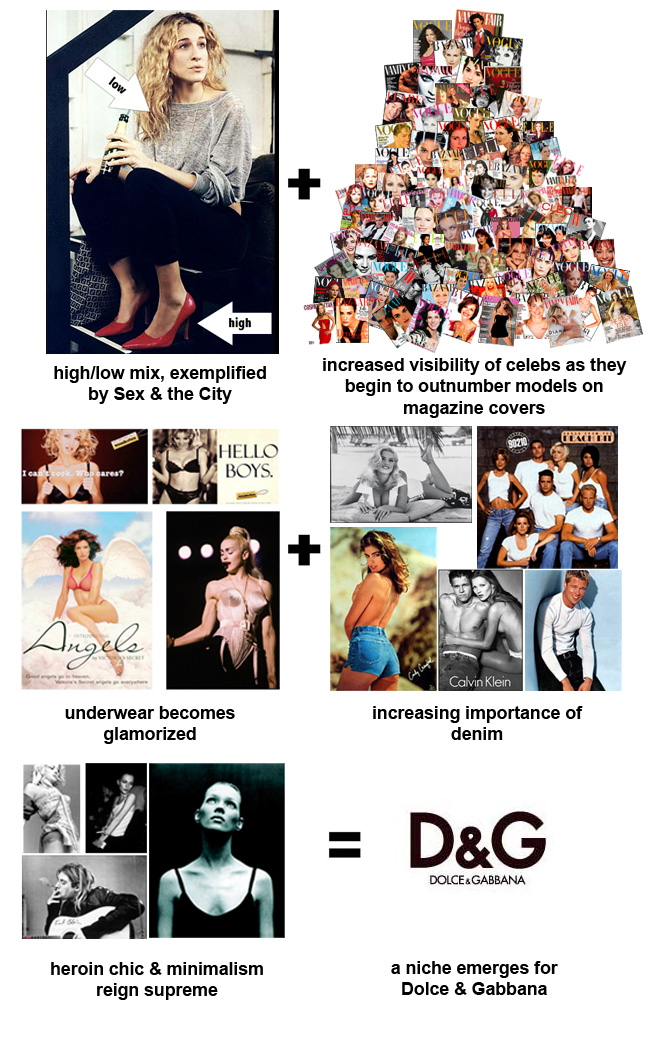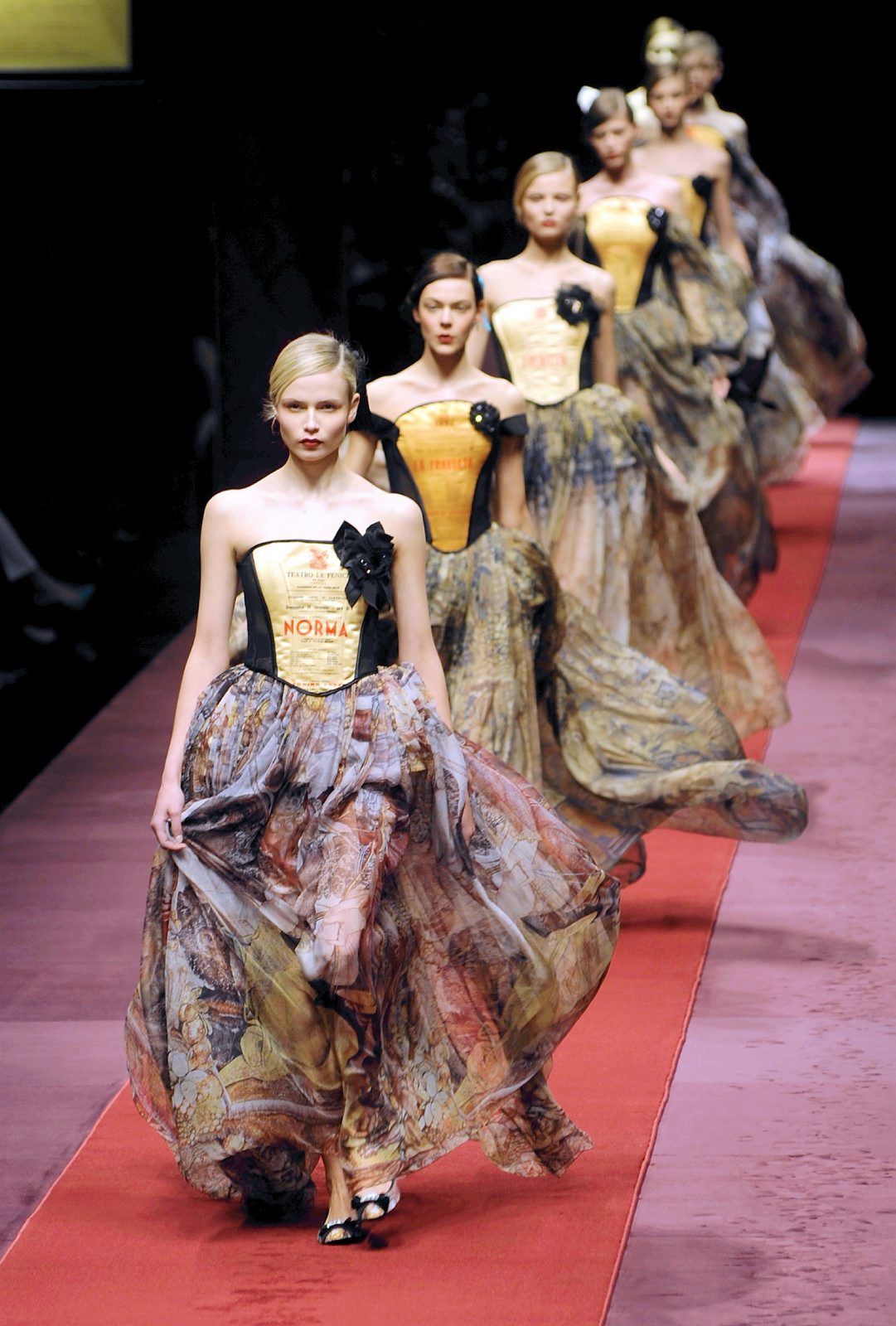The Roots

The Dolce & Gabbana style is inspired by Sicily, represented in a modern context with a hint of the past.
"We had a vision at the beginning, and we remain faithful to it. We believed in the strength of our message, even in periods when everything seemed to go against our beliefs. Our inspiration has always come from Italian culture and from Hollywood glamor. We also like playing with roles, with opposites, with masculine and feminine, black and white, sacred and profane." ~Domenico Dolce & Stefano Gabbana (SDA Bocconi)
Influences in Culture
In addition to their own personal backgrounds, the design team developed their brand within a niche opened up by the social climate of the late 80s and early 90s.
Below is my graphic depiction of how it all came together...

Codes of Style

Every brand has its own stylistic codes (or should)... they distinguish the collections from others, and make each item identifiable with the brand. The following are DG's key codes:

hyper-femininity • glamor • youth • zebra & cheetah prints • flowers • black & white • gold • rosaries • corsets & bras • fetish •Mediterranean • Baroque • Neo-Realism • Hollywood • embroidery • black lace • coppole hats • opposites (high-low fabric mixes, gender-bending, love & violence, sex & religion, see & don't see, old world & modern, etc)
Merchandising is fundamental to DG. Every single item under the brand's name reflects the brand codes and the influence of the main collection.
From Maison to Vertically Integrated Company
The History
 Domenico Dolce was born in Palermo in 1958; Stefano Gabbana was born in Milan in 1962
Domenico Dolce was born in Palermo in 1958; Stefano Gabbana was born in Milan in 1962- 1985: the Dolce & Gabbana brand debuts with their first show through Milano Collezioni in the New Talents section (now operated through Camera Nazionale della Moda Italiana)
- 1988: signs production agreement for ready-to-wear with the Dolce Saverio company, owned by Domenico Dolce's family
- 1990s: expansion through licensing
- 1990: men's collection is launched
- 1994: a second line, D&G, is launched
- 2000s: the company becomes vertically-integrated by acquiring their own production companies (including Dolce & Gabbana Industria in Legnano for clothes and Incisa Val D'Arno for shoes and leather accessories) and their own store network around the world through wholly-owned companies and subsidiaries
- 2007: the company decides not to renew the license to produce the D&G line with Itierre, and has brings production in-house with the first line, Dolce & Gabbana. Remaining major licenses are with Procter & Gamble (fragrances), Luxottica (eyewear) and Binda (watches).
Growth Strategy
1987 - 1999: strong use of licensing to support brand growth
1999 - 2008: progressive in-house management of line extensions
Communications

The brand typically incorporates imagery from old Sicilian towns and street markets or images of dramatically staged human interaction, all with a mix of modernity and sensuality, and often provocation. The in-store environment supports the brand image through a mix of materials made to look both antique and modern-chic, romantic and sexy, with a strong element of Hollywood glamor.
 Dolce & Gabbana's catwalk uses a stage set to reflect the theme of the clothes, and uses video feed, pictures, etc during the show to further convey the inspiration. This imagery is now being incorporated into the company's media website in order to archive the collections and demonstrate the brand history and evolution. In fact, the company has put considerable effort into creating the brand environment online this year, both through the formulation of their online blogazine and e-commerce stores.
Dolce & Gabbana's catwalk uses a stage set to reflect the theme of the clothes, and uses video feed, pictures, etc during the show to further convey the inspiration. This imagery is now being incorporated into the company's media website in order to archive the collections and demonstrate the brand history and evolution. In fact, the company has put considerable effort into creating the brand environment online this year, both through the formulation of their online blogazine and e-commerce stores.
 Celebrity endorsement is important for the brand's Hollywood appeal, through both public appearances and dedicated ad campaigns. In addition to young starlets, they use the best and most known photographers and models in their ads.
Celebrity endorsement is important for the brand's Hollywood appeal, through both public appearances and dedicated ad campaigns. In addition to young starlets, they use the best and most known photographers and models in their ads.

The two designers are also very social, and are often photographed mixing it up in some of Italy's most glamorous night scenes. Not only does this allow for photo-ops in the world press, but it also serves to validate the brand, as if to say "We live the lifestyle that we are designing for."
Ownership
The company is still fully owned by Domenico Dolce and Stefano Gabbana, much like Armani and his company. While this freedom from the demands of shareholders seeking quarterly profits allows the designers creative discretion, it also provides them with the luxury of being able to strategically plan for the future. Also like Armani, the company which grew through licensing agreements still earns approximately 35-40% of total annual brand revenues through licensing revenues, although many of the licensees have been internally acquired.
However, the challenge of full ownership is that the company accepts full risk in the case that problems emerge. This is a big risk to take, but in the case of Dolce & Gabbana, it seems to be paying off... literally!
By the way, TIME has a great article on the designers and their company. It's a couple of years old, but still a good read. Check it out!